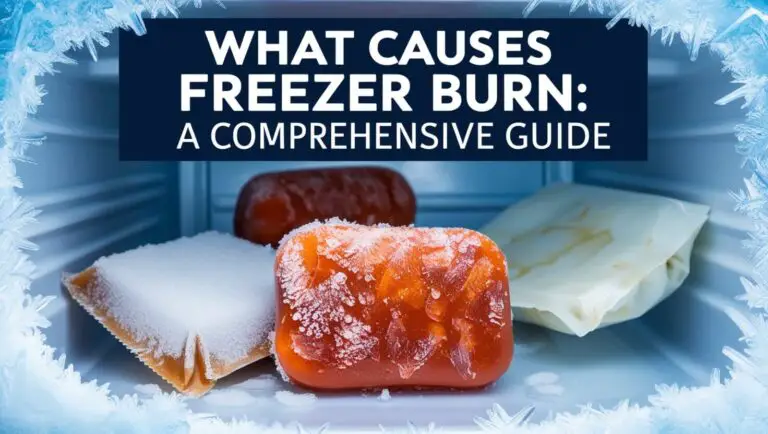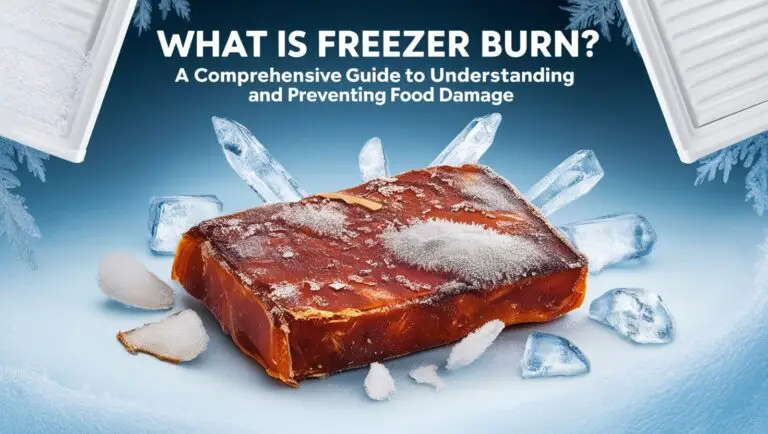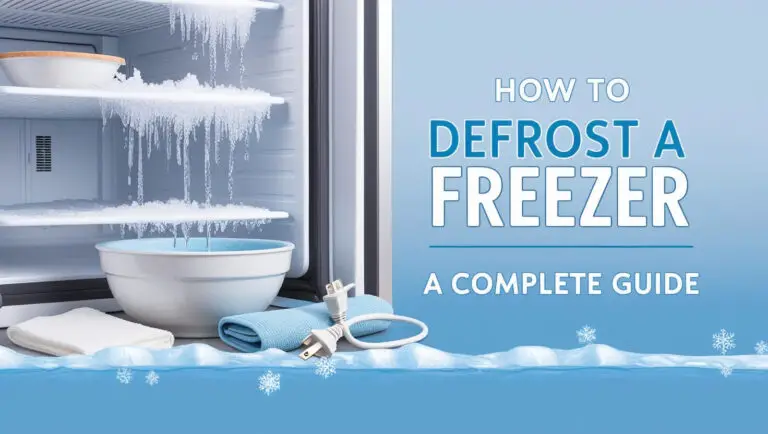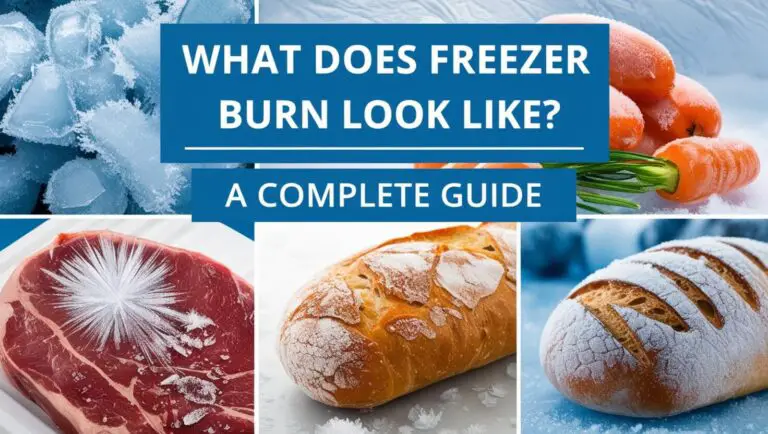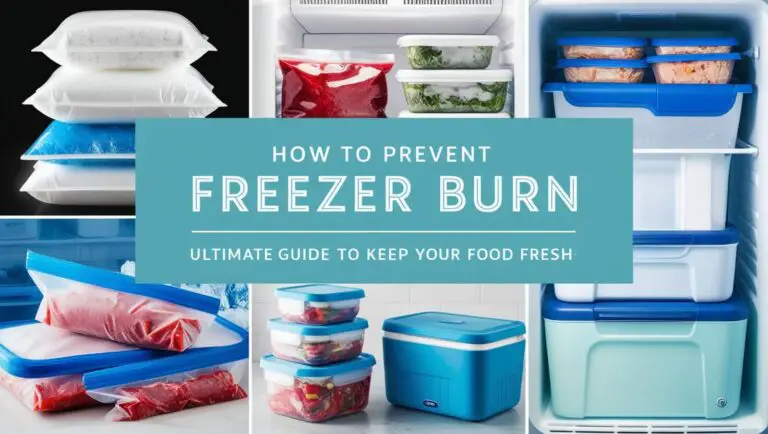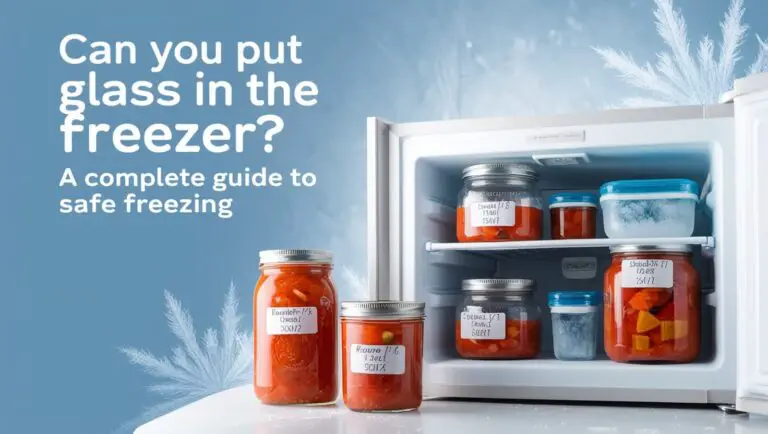What Temperature Should a Freezer Be?
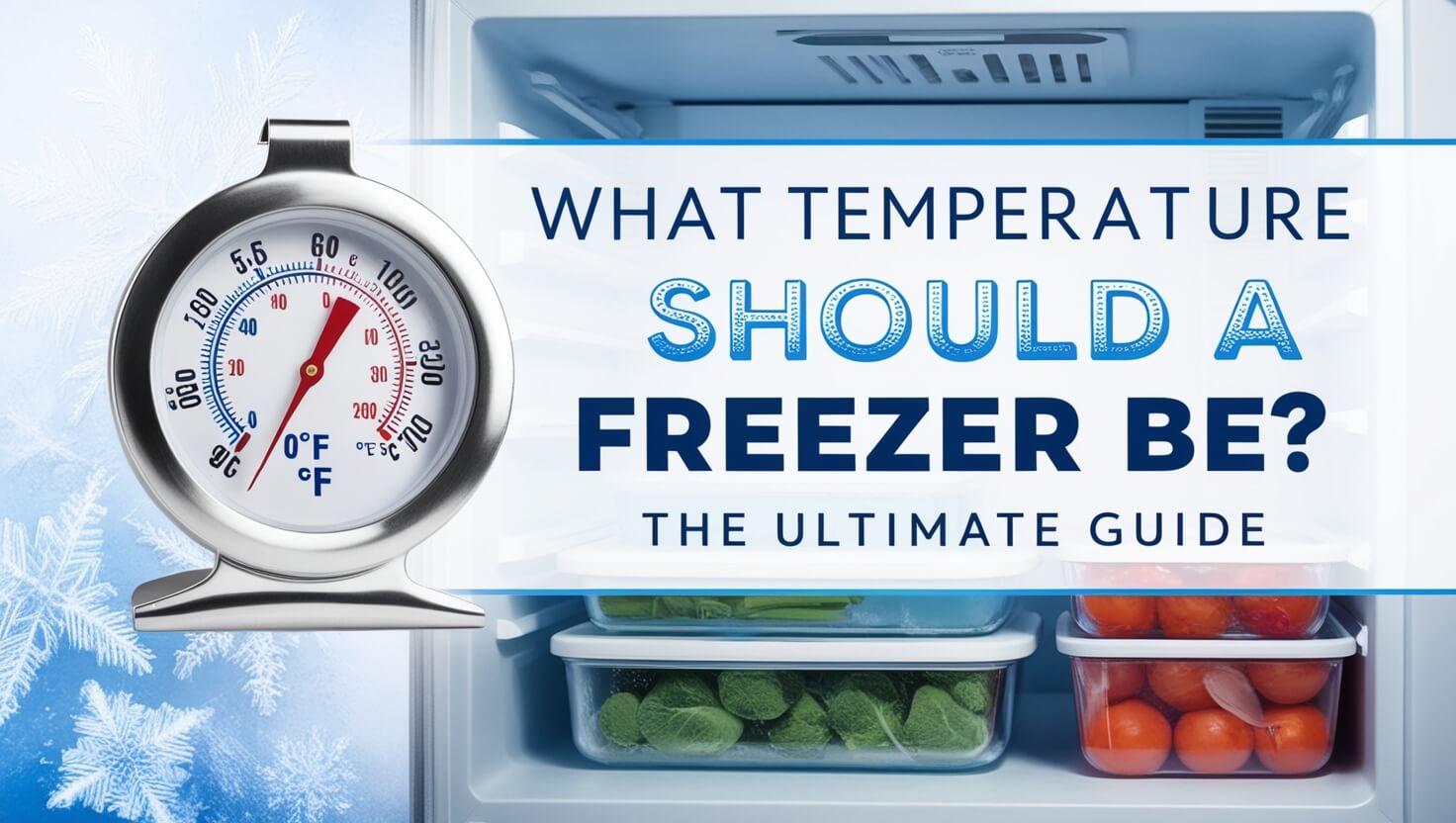
Have you ever wondered if your freezer is cold enough to keep your food safe? Or maybe you’re curious about the best temperature to prevent freezer burn and maintain food quality. Look no further! This comprehensive guide will answer the question “What temperature should a freezer be?” and provide you with all the information you need to keep your frozen foods in top condition.
The Ideal Freezer Temperature
When it comes to freezer temperature, there’s a sweet spot that balances food safety, quality preservation, and energy efficiency. Let’s dive into what experts recommend and why.
The FDA’s Recommendation
The U.S. Food and Drug Administration (FDA) recommends setting your freezer temperature at or below 0°F (-18°C). This isn’t just an arbitrary number – there’s solid science behind it.
Why 0°F (-18°C) is the Magic Number
At 0°F, most bacteria that cause food spoilage are inactive. While they’re not killed at this temperature, their growth is effectively stopped. This means your food stays safe to eat for much longer periods.
But there’s more to it than just food safety. At this temperature:
- Ice crystals remain small, minimizing damage to food cells
- Enzymatic reactions that can cause flavor changes slow down significantly
- The risk of freezer burn is greatly reduced
Understanding Freezer Temperature Ranges
While 0°F is the target, it’s helpful to understand what happens at different temperature ranges.
Too Warm: Risks of Higher Temperatures
If your freezer temperature creeps above 0°F, you’re entering a danger zone:
- At 10°F (-12°C): Food quality starts to decline more rapidly
- Above 32°F (0°C): Ice begins to melt, and bacteria can become active again
Even small temperature fluctuations can impact food quality over time. That’s why maintaining a consistent temperature is crucial.
Too Cold: Is There Such a Thing?
You might think that the colder your freezer, the better. But is this true?
While food safety isn’t compromised by temperatures below 0°F, there are a few considerations:
- Energy consumption increases
- Some freezers may struggle to maintain extremely low temperatures
- Very low temps can make ice cream too hard to scoop easily
For most home freezers, aiming for 0°F provides the best balance of food preservation and practicality.
Factors Affecting Freezer Temperature
Several factors can influence your freezer’s ability to maintain the ideal temperature.
Environmental Influences
Your freezer doesn’t exist in a vacuum. External factors play a role:
- Room temperature: A freezer in a hot garage will work harder than one in a cool basement
- Humidity: High humidity can make your freezer work overtime
- Ventilation: Poor airflow around the freezer can affect its performance
Freezer Location and Its Impact
Where you place your freezer matters:
- Away from heat sources like ovens or direct sunlight
- With enough space around it for proper air circulation
- On a level surface to ensure the door seals properly
Consider these factors when deciding where to put your freezer for optimal performance.
How to Set Your Freezer Temperature
Now that you know the ideal temperature, how do you actually set it?
Digital vs. Dial Controls
Modern freezers often have digital controls, making it easy to set an exact temperature. Older models might have a dial with numbers (usually 1-5 or 1-7).
For dial controls:
- Start at the middle setting
- Wait 24 hours and check the temperature
- Adjust accordingly
Step-by-Step Guide to Adjusting Freezer Temperature
- Locate your freezer’s temperature controls
- Set to 0°F (or the middle setting for dial controls)
- Wait 24 hours for the temperature to stabilize
- Check the temperature with a thermometer
- Make small adjustments if needed
- Repeat steps 4-5 until you reach the desired temperature
Remember, patience is key. Give your freezer time to adjust between changes.
Measuring Freezer Temperature Accurately
Knowing how to measure your freezer’s temperature accurately is crucial for maintaining food safety and quality.
Using a Freezer Thermometer
A freezer thermometer is your best friend for monitoring temperature. Here’s how to use one:
- Place the thermometer in the center of the freezer
- Wait at least 5-8 hours before taking a reading
- Check the temperature without removing the thermometer
- For the most accurate results, check at different times of day
Invest in a good quality thermometer – it’s a small cost for peace of mind.
DIY Methods to Check Freezer Temperature
No thermometer? No problem. Try these simple tests:
- Ice cream test: If ice cream is rock-hard, your freezer might be too cold
- Ice cube test: Place an ice cube in a sealed plastic bag. If it melts within 24 hours, your freezer is too warm
While these methods aren’t as accurate as a thermometer, they can give you a general idea of your freezer’s performance.
Signs Your Freezer Temperature Isn’t Right
Your freezer might be trying to tell you something. Learn to recognize the signs of temperature issues.
Visible Clues of Incorrect Temperature
Look out for these warning signs:
- Frost or ice buildup: Could indicate temperature fluctuations
- Soft or melting ice cream: Suggests the freezer is too warm
- Freezer burn on food: Often a result of temperature changes
Food Quality Indicators
Your food can also provide clues:
- Meat developing ice crystals: Might indicate temperature fluctuations
- Change in texture of frozen vegetables: Could be from partial thawing and refreezing
- Off-flavors in frozen foods: Sometimes a result of temperature issues
Pay attention to these signs to catch problems early.
The Impact of Freezer Temperature on Food Safety
Temperature plays a crucial role in keeping your frozen foods safe to eat.
Bacterial Growth and Freezer Temperature
At 0°F, bacterial growth is effectively stopped. However:
- Some bacteria can survive freezing
- If temperatures rise, bacteria can become active again
- Proper thawing is crucial to prevent bacterial growth
Food Preservation Duration at Different Temperatures
The colder your freezer, the longer food stays safe:
- At 0°F: Most foods stay safe indefinitely (quality may decline)
- At 10°F: Food safety duration decreases significantly
- Above 32°F: Food safety becomes a major concern
Remember, while frozen foods can be safe indefinitely, quality will decline over time.
Preventing Freezer Burn
Freezer burn is a common issue, but understanding its causes can help you prevent it.
The Role of Temperature in Freezer Burn
Freezer burn occurs when moisture escapes from food and forms ice crystals on the surface. Stable temperatures help prevent this by:
- Minimizing temperature fluctuations
- Reducing the formation of ice crystals
- Slowing the rate of moisture loss from foods
Proper Food Packaging Techniques
Combine proper temperature with good packaging:
- Use freezer-safe containers or bags
- Remove as much air as possible before sealing
- Wrap foods tightly in plastic wrap or aluminum foil
- Label packages with contents and date
Good packaging practices work hand-in-hand with proper temperature control to keep your food in top condition.
Energy Efficiency and Freezer Temperature
Balancing food safety with energy efficiency is possible with the right approach.
Finding the Balance: Cold Enough vs. Energy Consumption
While colder temperatures preserve food better, they also use more energy. Here’s how to find the sweet spot:
- Set your freezer to 0°F – it’s cold enough for food safety without excessive energy use
- Avoid setting the temperature lower than necessary
- Consider using a “holiday mode” for periods of low use
Tips for Maintaining an Energy-Efficient Freezer
- Keep your freezer full (use water bottles if needed)
- Organize contents for quick access to reduce door-open time
- Ensure door seals are in good condition
- Defrost manual-defrost freezers regularly
- Keep the freezer away from heat sources
These practices help your freezer maintain its temperature with less energy.
Common Freezer Temperature Myths Debunked
Let’s clear up some misconceptions about freezer temperatures.
“Colder is Always Better”
While it’s true that colder temperatures preserve food longer, there’s a point of diminishing returns:
- Below 0°F, you’re using more energy without significant benefits
- Extremely low temperatures can make some foods too hard to use easily
- Most home freezers aren’t designed to maintain extremely low temperatures
“Freezer Temperature Doesn’t Matter for Short-Term Storage”
This is a dangerous myth:
- Even short-term temperature fluctuations can affect food quality
- Bacteria can multiply quickly if temperatures rise above safe levels
- Proper temperature is crucial for both long and short-term storage
Always maintain proper freezer temperature, regardless of how long you plan to store food.
Freezer Temperature for Different Food Types
Not all frozen foods are created equal when it comes to ideal storage temperatures.
Ideal Temperatures for Meats and Poultry
For meats and poultry, the standard 0°F is perfect:
- Prevents bacterial growth effectively
- Maintains texture and flavor for several months
- Allows for long-term storage without safety concerns
Optimal Freezing for Fruits and Vegetables
Fruits and vegetables benefit from quick freezing:
- Use the coldest setting when adding new produce
- Once frozen, maintain at 0°F
- Consider blanching vegetables before freezing for best quality
Dairy and Ice Cream: Special Temperature Considerations
Dairy products, especially ice cream, have unique needs:
- Ice cream is best stored between -5°F and -10°F for ideal texture
- Other dairy products can be stored at the standard 0°F
- Consider using a separate freezer for ice cream if you’re a connoisseur
Understanding these differences can help you optimize your freezer use for different food types.
Troubleshooting Freezer Temperature Issues
Even with proper care, freezer temperature problems can occur. Here’s how to address common issues.
When Your Freezer Won’t Stay Cold
If your freezer isn’t maintaining the right temperature:
- Check the door seal for damage or gaps
- Ensure the freezer isn’t overpacked, blocking air circulation
- Clean the condenser coils if they’re dusty
- Check for frost buildup and defrost if necessary
- If problems persist, consider calling a professional
Dealing with Temperature Fluctuations
Temperature fluctuations can be tricky:
- Monitor with a freezer thermometer to catch patterns
- Check if fluctuations coincide with defrost cycles (normal in some models)
- Ensure the freezer isn’t near heat sources or in direct sunlight
- Consider upgrading to a model with better temperature stability if issues continue
Regular monitoring and maintenance can prevent many temperature-related problems.
The Relationship Between Fridge and Freezer Temperatures
For combination fridge-freezers, understanding the interplay between compartments is crucial.
Balancing Temperatures in Combination Units
In a fridge-freezer combo:
- The freezer usually controls the overall cooling
- Setting the freezer colder may make the fridge too cold
- Find a balance that keeps both compartments at their ideal temperatures
Standalone Freezers vs. Fridge-Freezer Combos
Standalone freezers often have advantages:
- Better temperature control
- More consistent temperatures
- Often more energy-efficient for freezer storage
Consider your needs when choosing between standalone and combination units.
Advanced Freezer Features for Temperature Control
Modern freezers offer features to help maintain optimal temperatures.
Fast Freeze Options
Many freezers now include a “fast freeze” or “power freeze” option:
- Temporarily lowers temperature to freeze new items quickly
- Helps preserve texture and nutrients in fresh foods
- Automatically returns to normal settings after a set time
Smart Freezers and Temperature Management
Smart technology is entering the freezer world:
- Wi-Fi connected freezers allow remote temperature monitoring
- Some models send alerts for temperature fluctuations
- Advanced systems can even predict and prevent temperature issues
These features can provide peace of mind and better food preservation.
Seasonal Adjustments to Freezer Temperature
Your freezer’s performance can change with the seasons.
Summer vs. Winter Settings
In summer:
- Your freezer works harder to maintain temperature
- You might need to set it slightly colder to compensate
- Check more frequently for temperature stability
In winter:
- Cold ambient temperatures can actually make your freezer too cold
- You might need to adjust to a slightly warmer setting
- Be cautious if your freezer is in an unheated space
Humidity and Its Effect on Freezer Performance
High humidity can impact your freezer:
- It can cause more frost buildup
- This can affect the freezer’s efficiency
- In humid climates, more frequent defrosting may be necessary
Consider using a dehumidifier in the room where your freezer is located during humid months.
The Science Behind Freezing Foods
Understanding the science can help you appreciate why proper freezer temperature is so important.
How Freezing Preserves Food
Freezing preserves food by:
- Slowing down molecular movement, which stops most chemical reactions
- Turning water into ice, making it unavailable for bacterial growth
- Preserving nutrients that would otherwise break down over time
The Importance of Quick Freezing
Quick freezing at very low temperatures:
- Forms smaller ice crystals, which cause less damage to food cells
- Helps maintain better texture and flavor after thawing
- Is especially important for fruits, vegetables, and seafood
This is why commercial flash-freezing produces such high-quality frozen foods.
Freezer Organization for Optimal Temperature Maintenance
How you organize your freezer can impact its ability to maintain a consistent temperature.
Airflow Considerations
Proper airflow is crucial:
- Don’t overfill your freezer – leave some space between items
- Keep vents clear of food packages
- Arrange items to allow cold air to circulate freely
Best Practices for Loading Your Freezer
Follow these tips for optimal freezer performance:
- Place new items in the back, moving older items forward
- Group similar items together for easy access
- Use freezer-safe containers to maximize space and minimize air exposure
- Label everything with contents and date
A well-organized freezer runs more efficiently and keeps food at a more consistent temperature.
Freezer Temperature During Power Outages
Power outages can be stressful when you have a freezer full of food. Here’s what you need to know.
How Long Food Stays Frozen Without Power
The duration depends on several factors:
- A full freezer will stay cold longer than a partially full one
- A well-insulated freezer maintains temperature better
- Generally, food will stay frozen for about 24-48 hours if the door remains closed
Steps to Take During an Outage
If you experience a power outage:
- Keep the freezer door closed as much as possible
- Cover the freezer with blankets for extra insulation
- Have a cooler and ice ready to transfer food if the outage lasts more than a day
- Once power is restored, check food temperatures before consuming
Being prepared can help you minimize food loss during unexpected outages.
Professional Insights: What Experts Say About Freezer Temperature
Let’s hear from the professionals about freezer temperature management.
Food Scientists’ Recommendations
Food scientists emphasize:
- The importance of consistent temperatures
- The role of proper packaging in maintaining food quality
- The need for regular temperature checks
They also stress that while 0°F is ideal, slight variations won’t immediately compromise food safety.
Appliance Manufacturers’ Guidelines
Manufacturers generally agree on key points:
- Most recommend setting freezers to 0°F
- They stress the importance of not overloading the freezer
- Many suggest using the freezer’s built-in thermometer in conjunction with a standalone one for accuracy
Always consult your freezer’s manual for specific recommendations.
Closing Thoughts: Maintaining the Perfect Freezer Temperature
Maintaining the right freezer temperature is crucial for food safety, quality, and energy efficiency. Here’s a quick recap of the key points:
- Set your freezer to 0°F (-18°C) for optimal food preservation
- Use a freezer thermometer to regularly check and maintain this temperature
- Be aware of factors that can affect freezer temperature, like location and seasonal changes
- Organize your freezer for optimal airflow and efficiency
- Pay attention to signs that your freezer might not be cold enough
By following these guidelines, you’ll ensure that your frozen foods stay safe, maintain their quality, and taste great when you’re ready to use them. Remember, a well-maintained freezer is an investment in your health and your wallet, reducing food waste and energy costs.
Now that you’re armed with this knowledge, go forth and conquer the world of frozen foods with confidence!

